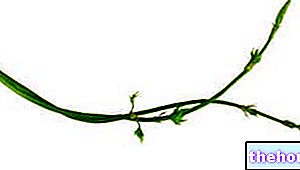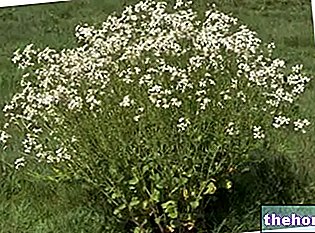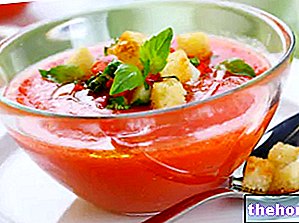Generality
Turnip greens are foods of the plant kingdom. These are vegetables (leaves and flowers) that fall into the VI and VII food groups, as they are rich in vitamin C and vitamin A, as well as fiber and folate.

Description
Turnip greens can be found in different forms, slightly different between varieties. Typically, they are marketed as whole shoots (still joined by the root base), as flowers (inflorescence) without leaves and, alas, also as leaves without flowers. They are green in color and vary in length between 15 and 100cm (on average).
The leaves appear elliptical and jagged, the inflorescences grouped and more or less globose but always well closed. The stems and stems are more or less thick, turgid and, at times, need to be superficially shelled.
It is always advisable to buy fresh turnip greens; this characteristic is manifested by the overall turgidity of the plant (leaves and stems must not be limp) and with the total closure of the flowers.
Disambiguation of turnip greens
Some readers (mostly from northern Italy) will ask: "Why on earth, until now, in "buying turnip greens, have I never come across flowers? I have always bought only small bunches of leaves, green and red or green and white!".
Unfortunately, without having sufficient knowledge to distinguish the various products, it is easy to fall into the "deception (or" omission) of the shopkeepers. These, who know perfectly the different species and the costs, often sell the leaves of the red turnip or the white turnip under the name of "turnip greens". In fact, these are "tops" and also "turnip"! Where is the deception? Simple: in common parlance, turnip greens are the flowers and leaves of a specific plant (Subspecies sylvestris) and not the leaves of any other root turnip (Subspecies turnip). The latter, although edible, represent a food of little gastronomic value; just think that, until recently, most of it was destined for animal fodder. In practice, the leaves of the common turnip represent the waste (albeit edible) of the herbaceous Brassica rapa rapa.
To avoid any form of "misunderstanding", I suggest looking for the words "broccoli di rapa" (among the market or supermarket tags); if the traditional wording "cime di rapa" appears, it is better to make sure that, among the tufts, the phantom flowers also emerge. Another useful clue for verification is certainly the origin; despite being a typical product of southern Italy, the vast majority of real turnip greens on the market come from the fields of Lazio.
Hints of cultivation
Turnip greens are autumn - winter vegetables; sowing (or transplanting) takes place between the last summer months and the first autumn months. Depending on the variety, the early turnip greens will become ready after two or three months, while the late ones will take another 3 or 4 months.
Turnip greens do not need particular attention in the cultivation and it is sufficient to space the plants at 30cm from each other. The soil and irrigation are more or less the same as for root turnips, cabbage, broccoli, etc. The most important pest for turnip greens (which, in the case of organic farming, requires protection with special nets) is the cabbage fly.
Gastronomic applications of turnip greens
Turnip greens should be eaten cooked. The respective preparation methods vary essentially according to the product to be obtained, but what all the recipes with turnip greens have in common is cleaning and husking; first of all, it is advisable to wash them thoroughly; secondly, they require the elimination (if present) of the root portion adhering to the head and, in the case, of the damaged leaves.
It is possible to distinguish the various procedures on the basis of: raw material and recipe.
- In the case of early and small turnip greens, if you want to boil them: throw only the leaves in boiling water and, after 5 ", also the flowers; after another 5" drain everything.
- If you want to cook them for stewing: gently brown them in oil and onion, taking care to use very uniform sizes (reducing them or cutting the stems and stems lengthwise), then deglaze with wine, add water and cook slowly with the lid on for 30 ".
- If, on the other hand, the raw material consists of late and large turnip greens, in addition to what is described above, during the husking and cutting phase it becomes necessary to peel the stems and stems to eliminate the woody outer portion.
- The best-known recipes of turnip tops are: Orecchiette with turnip tops (first course), Stewed turnip tops (side dish), Boiled turnip tops and possibly sautéed in a pan (side dish), Turnip tops and meat.
Turnip greens with chicken sausage
Problems with playing the video? Reload the video from youtube.
- Go to the Video Page
- Go to the Video Recipes Section
- Watch the video on youtube
Nutritional characteristics
In addition to those of the tops, it was also chosen to report the values of the turnip leaves since, in equivocation or not, they represent a good part of the total consumption of Brassica rapa.
As "it is clear from the tables below, turnip greens and leaves are low-energy foods. The calories are distributed equally between fructose and low biological value proteins and, in addition to being cholesterol-free, contain a good supply of dietary fiber.
It is probable that the potassium content is excellent and the sodium content very low but, in the absence of precise data, we will refrain from considering them foods particularly suitable for the diet against hypertension.
Among the mineral salts, iron stands out, useful in the treatment of sideropenic anemia, but also calcium does not disappoint (especially in the leaves).
As for vitamins, the leaves are richer in niacin than broccoli but both foods contain excellent amounts of vit. A (in the form of carotenoids) and vit. C.
Although not mentioned, both folate (necessary in large quantities for the diet of pregnant women) and antioxidants with anti-tumor function are present in good concentrations.
The only contraindication to the consumption of turnip greens refers to the high content of purines, molecules incorrectly metabolized by those suffering from hyperuricemia and / or gout.
NB. Cooking turnip greens in water significantly reduces their content in mineral salts (by dilution) and thermolabile vitamins.
Nutritional values

Other Foods - Vegetables Garlic Agretti Asparagus Basil Beets Borage Broccoli Capers Artichokes Carrots Catalonia Brussels sprouts Cauliflower Cabbage and Savoy cabbage Red cabbage Cucumber Chicory Turnip greens Onion Sauerkraut Watercress Edamame Chives Chanterelles Flour Cassava Flowers Pumpkin Flour Edible Flowers Pumpkin Seasonal Fruits and Vegetables Endive Salads and Salads Strengthening Salad Lettuce Aubergines Vegetables Nettle Pak-Choi Parsnip Potatoes American Potato Peppers Pinzimonio Tomatoes Leeks Parsley Radicchio Turnips Red Turnips Radishes Rocket Shallots Endive Celery Celeriac Seeds Sprouted Spinach Truffle Valianamberi or Jerusalem artichoke laxatives Saffron Pumpkin Zucchini Vegetables - Nutritional properties OTHER VEGETABLE ITEMS Categories Food Alcoholics Meat Cereals and derivatives Sweeteners Sweets Offal Fruit Dried fruit Milk and derivatives Legumes Oils and fats Fish and fishery products Cold cuts S pezie Vegetables Health recipes Appetizers Bread, Pizza and Brioche First courses Second courses Vegetables and Salads Sweets and Desserts Ice creams and sorbets Syrups, liqueurs and grappa Basic preparations ---- In the kitchen with leftovers Carnival recipes Christmas recipes Light diet recipes Women's Day, Mum, Dad Recipes Functional Recipes International Recipes Easter Recipes Recipes for Celiacs Recipes for Diabetics Recipes for Holidays Recipes for Valentine's Day Recipes for Vegetarians Protein Recipes Regional Recipes Vegan Recipes




























